When the peninsula was connected to the Sydney water supply
Ninety years ago, the peninsula was connected to the main Sydney water supply through a pipeline from Pymble to Beacon Hill.
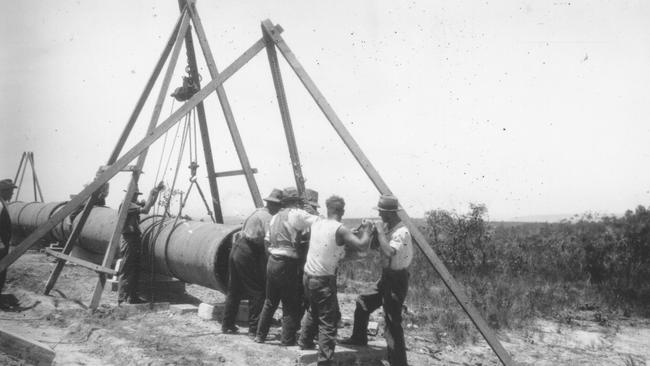
Manly
Don't miss out on the headlines from Manly. Followed categories will be added to My News.
Ninety years ago, the peninsula was connected to the main Sydney water supply through a pipeline from Pymble to Beacon Hill.
And it not a moment too soon – by the late 1920s the population on the northern beaches had reached 50,000 – and growing at 6 per cent annually – and Manly Dam was unable to quench the thirst of so many people’s needs, so the Metropolitan Water, Sewage and Drainage Board was forced to act.

Manly Dam was completed in 1892 and its dam wall was raised in 1909, 1914 and again in 1922, by which time it could hold 441 million gallons (about 2004 megalitres).
But even this was not enough to slake the peninsula’s thirst, not even when supplemented by the main metropolitan system via pipes from a reservoir at Mosman that were laid under Middle Harbour near The Spit in 1906 and near Clontarf in 1920.
The situation was exacerbated in 1928 by an extended period without rain that depleted Manly Dam and the Water Board was considering the construction of another dam in the same area as Manly Dam but at a higher altitude.

In January 1929, the situation was so dire that water restrictions were introduced to the northern beaches.
Manly Dam was down to just 35 per cent of its capacity and there was only enough water to last two months.
The Water Board’s chief engineer, Gerald Haskins, recommended a 30-inch (76.2cm) pipe be laid from the Pymble Reservoir to a new reservoir at Beacon Hill, from where water would be piped to existing trunk mains.
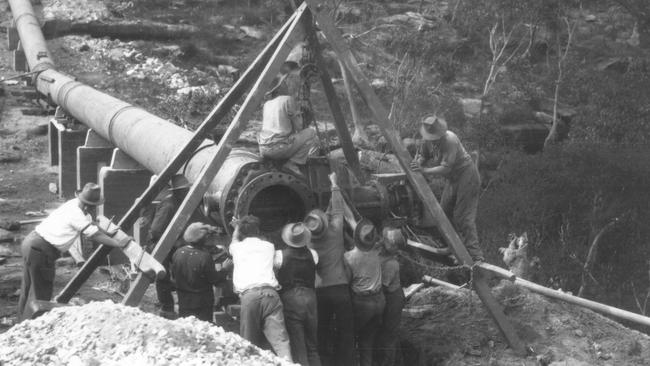
Haskins figured that the population of the northern beaches by 1945 would be 90,000 people, each consuming a maximum of 90 gallons (409 litres), totalling 8.5 million gallons (38.6 million litres) a day.
To supply that volume of water to the northern beaches from Pymble required the upgrading and amplification of existing infrastructure, as well as the construction of the pipeline connecting Pymble to Beacon Hill, a reservoir at Beacon Hill capable of holding 18 million gallons (82 million litres) and pressure-reducing valves between the new reservoir and the existing main trunk lines on the northern beaches.

Haskins also believed that wood-stave pipes should be used for the bulk of the 8½ miles (13.7km) distance between Pymble and Beacon Hill.
Wood-stave pipes were lighter than steel and also cheaper.
The waterlogged wood was also impervious to insect attack, while steel pipes corroded, resulting in lower pressure and dirty water.
The wooden pipes were covered in hessian impregnated with bitumen and rolled in sand to protect the steel bands that kept the wood staves in place.
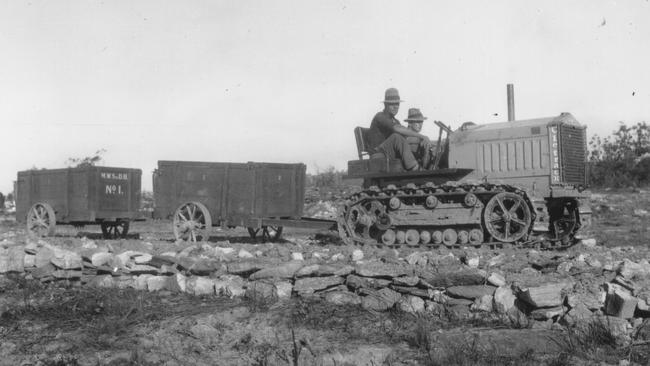
Construction of the pipeline was begun in May 1929 by the Australian Wood Pipe Company, which was situated on the Lane Cove River.
For most of its length, the pipeline sat on concrete saddles or went underground and, just below the tidal limit of Middle Harbour, a 24m steel truss bridge with abutments was built across the waterway to carry the pipeline.

Only where the water pressure in the pipeline was higher were concrete-lined mild steel pipes used, these being manufactured under contract to Hume Steel Ltd.
The internal diameter of the pipeline was 30 inches (76.2cm).
To minimise costs, most of the pipeline was laid above ground on concrete saddles on Crown land and only underground when it needed to go under public roads.

At times, transport of pipes and materials over rough ground through cleared bushland was difficult and was only overcome by the use of tractors with caterpillar tracks.
Access tracks were built through the bush and a small wooden bridge was built across Middle Harbour across which materials were transported.
The pipeline crossed Middle Harbour just below the tidal limit on a steel truss bridge 80 feet (24.4m) long supported on concrete piers designed to have one pipe and maintenance paths on each side of the pipe.
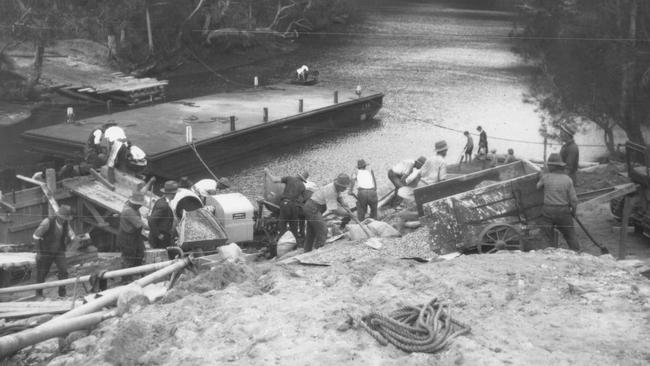
The bridge was constructed by James Hurll and Company and erected complete at the company’s works and then placed on a punt and taken to the site before being lifted into position – all within seven weeks of the contract being signed.

Water transit was availed upon whenever the tides favoured the workers, so pipes, sand and blue metal were brought in by punts the stages at the foot of the bridge’s supports.
The total length of the pipeline from, Pymble to Beacon Hill was 7.1 miles (11.4km) and the smaller pipe from Beacon Hill to Brookvale was 1.37 miles (2.2km).

Of that length, 29,700 feet (9052m) was of wood-stave, 3150 feet (960m) was of steel and 4500 feet (1371m) was of cast iron.
Initially a wood-stave reservoir with a capacity of a capacity of 50,000 gallons (227,300 litres) was built at Beacon Hill.
Work on the pipeline began on May 21, 1929, and was completed by January 6, 1930, after which rigorous testing was undertaken.
By the time the pipeline had been completed, it had cost £170,000.
The Pymble-Warringah Main, as it was called, was officially opened on February 12, 1930.
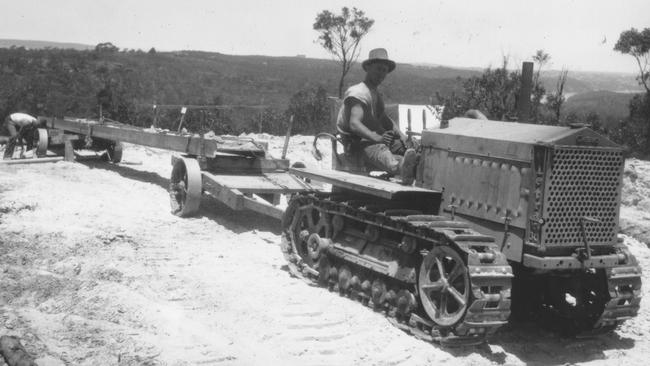
The new pipeline was able to supply 90 gallons (409 litres) per person per day, which was well up on the 60 gallons (273 litres) per person per day that had been available from Manly Dam, from which water now ceased to be drawn.
But the completion of the work meant about 300 men who had been employed solely for the job were laid off just as the Depression was biting hard.
A concrete reservoir was built at Beacon Hill in 1935.

Near the end of a severe drought between 1934 and 1942, the dam was brought back into service to augment the overstretched metropolitan supply.
The pumping plant at the dam had been dismantled and disposed of in 1936 but pumps were transferred from Engadine to bring Manly Dam back into service for nine months from January to October 1942, during which time it supplied 214 million gallons (973 megalitres) to the district.
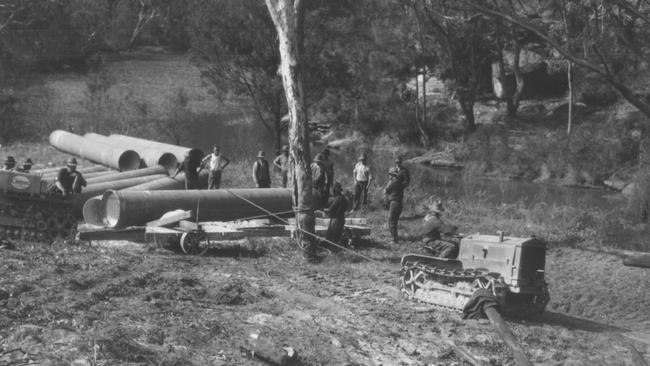
By the late 1950s, rapid development and the rising population on the northern beaches necessitated the replacement of the wood-stave pipe.
The section from Pymble to Middle Harbour was replaced by a 48-inch (122cm) concrete-lined steel pipe in 1955 and the rest of the pipeline to Beacon Hill was replaced in 1960.
At the same time, an additional storage capacity for 7 million gallons (32 million litres) was provided at Beacon Hill.

Since 1942, no water has been drawn from Manly Dam for residential purposes, although several hydraulics laboratories downstream from the dam frequently make use of small quantities of water from the dam.
In April 1954, a nine-year-old Frenchs Forest boy drowned after he fell into the reservoir, after which a fence was erected around it, although now the reservoir is roofed over.


